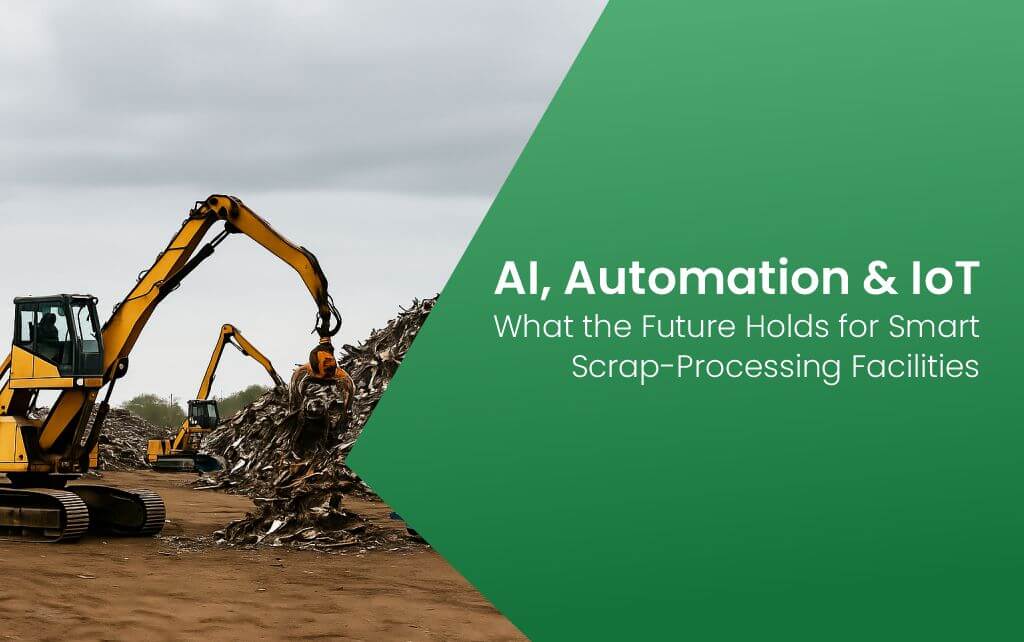AI, Automation & IoT: What the Future Holds for Smart Scrap-Processing Facilities
Smart scrap-processing facilities are stepping into a transformative phase of innovation. Recycling operations are being transformed into smart ecosystems through the integration of AI, Automation, and IoT, often collectively referred to as AIoT. From heavy metal piles to mixed e-waste operations—whichever the case, your facility will now enjoy real-time visibility, predictive insights, better safety, and greener operations.
This guide is about the core technologies changing the face of Scrap processing equipment and how you can benefit from them.
Understanding AIoT in Scrap Recycling
At its core, AIoT intermixes:
- AI for intelligent decisions—sorting scrap, predicting failures, and optimising flows.
- IoT for tracking in real-time—health of equipment, volume of materials, and environmental parameters.
- Automation for streamlined operations—managing bulk scrap efficiently with robotics and autonomous systems.
Put together, these technologies create a responsive, data-driven processing facility that maximises efficiency and minimises risk.
What AIoT Entails for Your Operation
Integrating AI, IoT, and automation transforms scrap-processing facilities by enhancing efficiency, safety, and adaptability. Here’s how:
1. IoT-Enabled Infrastructure
All machinery is fitted with sensors to monitor for vibration, temperature conditions, energy consumption, and production throughputs. This captured data gives total transparency in operations. It enables:
- Monitoring of live inventory to reduce cases of loss of materials.
- Predictive analytics for early fault detection.
- Energy optimisation based on trends in real-time usage.
2. Predictive Maintenance
AI utilizes IoT data to detect potential gear or bearing problems long before they develop into critical issues. Companies report:
- 15% reduction in unplanned downtime.
- Up to 20% increase in scrap processing equipment uptime.
- 25–40% reduction in maintenance costs.
3. AI-Powered Sorting & Optical Classification
AI vision systems and spectral sensors are capable of metal identification and contaminant detection. Some of the best systems worldwide reach over 95% classification accuracy and can provision contamination rate reductions of as high as 25%.
4. Automation & Robotics
Cranes, conveyors, and other kinds of autonomous and semi-autonomous machines work relentlessly to maintain smooth and safe operations. In the meantime, AI robots take the repetitive work, allowing skilled workers to concentrate on more rewarding and strategic operations.
5. Real-Time Workflow & Asset Tracking
Transportation equipment tracking improves billing, reduces delays, and enhances dispatch control through the integration of RFID tags, GPS trackers, and smart scales via intelligent dashboards.
6. Safety, Compliance & Environmental Controls
Air quality, emission, and dust sensors integrated with IoT help maintain safe and environmentally friendly work settings, while wearable devices monitor the health and usage of workers and automatically log data for audit purposes.
7. Data-Driven Continuous Optimisation
Insights generated by IoT systems centre around bottlenecks, machine inefficiencies, and market trends. Automated changes adjust production flow and inventory levels as required.
Common Challenges & How to Tackle Them
AIoT’s benefits are clear, but addressing challenges ensures smooth adoption and optimal returns:
- Upfront Investment: The cost of smart sensor networks, AI systems, as well as robotics is high. However, ROI typically comes about within 18-24 months.
- Legacy Integration: Retrofitting is required for older machines with edge IoT. Nevertheless, being able to interoperate is what modernisation should be all about.
- Workforce Adaptation: Proper training of the workforce concerning digital tools and AI oversight will put them in the right mindset that they are now solution providers and not a threat of replacement.
- Data Security Concerns: Increased risks of cyber threats with more connectivity. Installing a strong cybersecurity system protects the integrity of data and sensitive operational information from unauthorised access.
Daily Operations in a Smart Scrap Recycling Facility
Advanced technologies ensure seamless, efficient processes in smart scrap recycling facilities. Here’s how they transform operations:
- Upon arrival at the facility, vehicles are weighed on the IoT scales. RFID tags capture and log details of the scrap type and quantity.
- The feeding process is started with AI guidance that balances input loads.
- The shredding and shearing process is monitored via sensors, while the AI predicts maintenance requirements.
- On the conveyor belts equipped with AI-optical sensors, ferrous, non-ferrous, and non-metallic materials are sorted together.
- The bales are automatically processed, sorted, and tracked via IoT smart tags.
- The dashboards report on inventories, machine health, labour, and environmental metrics to trigger system adjustments.
Why AIoT Matters?
AIoT is transforming scrap processing, driving greater efficiency, enhanced safety, and sustainable practices. Here’s why it matters:
- Predictable Uptime: Fewer breakdowns; longer asset life.
- Operational Efficiency: Optimised labour and energy.
- Material Purity: Consistent high-value outputs.
- Worker Safety: A healthier and well-monitored environment.
- Sustainability: Lower emissions, lower waste, better regulatory compliance.
Your Path to a Smarter Facility
Transform your scrap processing operations step-by-step:
- Conduct an Audit: Find out what is manual, data-poor, or wasteful.
- Install IoT Sensors: Start with the very critical machinery.
- Implement AI Sorting Pilots: Scale based on results.
- Adopt Predictive Maintenance Software: Initiate small; expand in stages.
- Roll Out Dashboards & Training: This will empower operators with data.
- Integrate Robotics & Automation: Start with low-hanging fruit and tackle risky, repetitive tasks.
Conclusion
Smart scrap handling machines are no longer considered futuristic—they are in existence, proven, and already delivering value. Thanks to AIoT, scrap yards have become safer and more efficient, using data-driven insights to deliver higher-quality results while minimizing waste.
Are you prepared for a smarter, greener operation? Super Recycling can offer you a tailor-made AIoT integration roadmap that will move your scrap yard into a new-age era.


